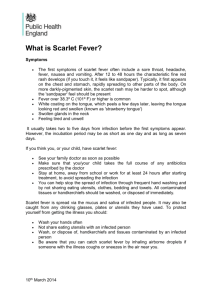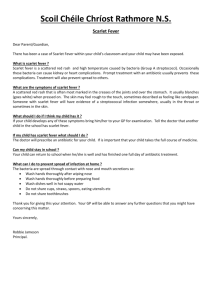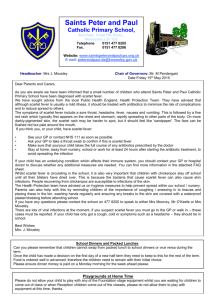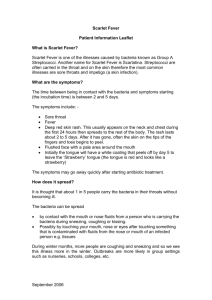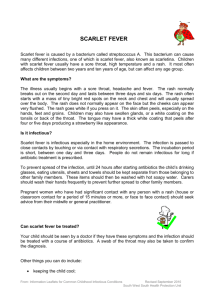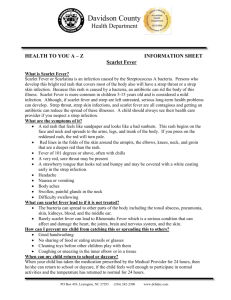Scarlet fever Have I got the right topic? All ages This CKS topic
advertisement
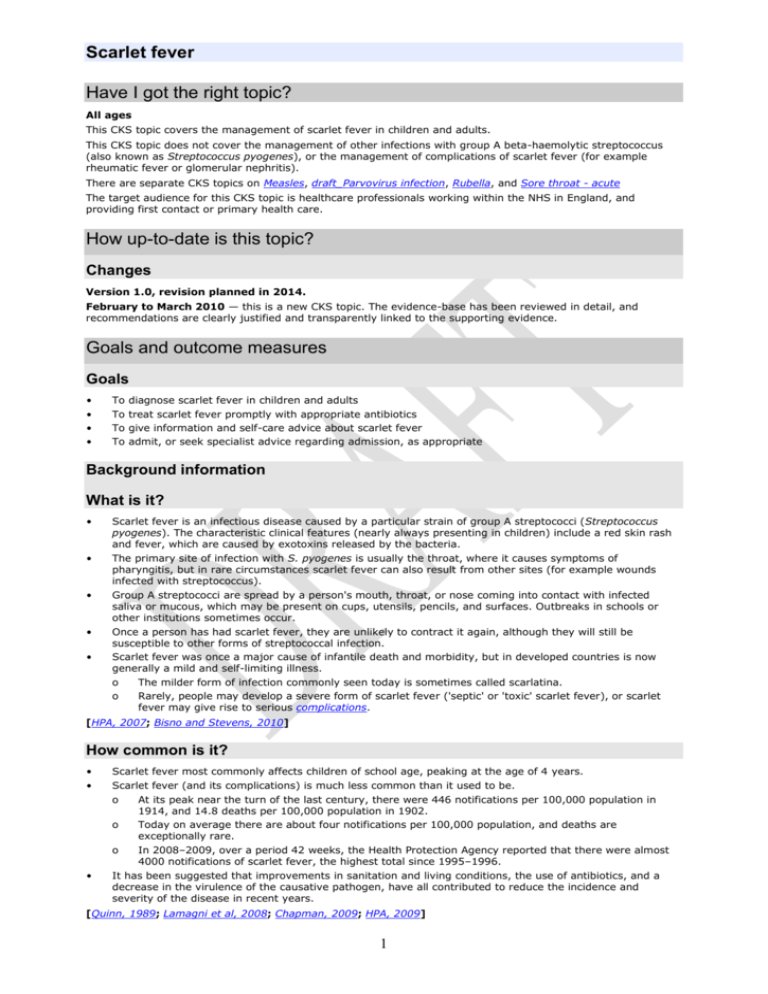
Scarlet fever
Have I got the right topic?
All ages
This CKS topic covers the management of scarlet fever in children and adults.
This CKS topic does not cover the management of other infections with group A beta-haemolytic streptococcus
(also known as Streptococcus pyogenes), or the management of complications of scarlet fever (for example
rheumatic fever or glomerular nephritis).
There are separate CKS topics on Measles, draft_Parvovirus infection, Rubella, and Sore throat - acute
The target audience for this CKS topic is healthcare professionals working within the NHS in England, and
providing first contact or primary health care.
How up-to-date is this topic?
Changes
Version 1.0, revision planned in 2014.
February to March 2010 — this is a new CKS topic. The evidence-base has been reviewed in detail, and
recommendations are clearly justified and transparently linked to the supporting evidence.
Goals and outcome measures
Goals
•
•
•
•
To
To
To
To
diagnose scarlet fever in children and adults
treat scarlet fever promptly with appropriate antibiotics
give information and self-care advice about scarlet fever
admit, or seek specialist advice regarding admission, as appropriate
Background information
What is it?
•
•
•
•
•
Scarlet fever is an infectious disease caused by a particular strain of group A streptococci (Streptococcus
pyogenes). The characteristic clinical features (nearly always presenting in children) include a red skin rash
and fever, which are caused by exotoxins released by the bacteria.
The primary site of infection with S. pyogenes is usually the throat, where it causes symptoms of
pharyngitis, but in rare circumstances scarlet fever can also result from other sites (for example wounds
infected with streptococcus).
Group A streptococci are spread by a person's mouth, throat, or nose coming into contact with infected
saliva or mucous, which may be present on cups, utensils, pencils, and surfaces. Outbreaks in schools or
other institutions sometimes occur.
Once a person has had scarlet fever, they are unlikely to contract it again, although they will still be
susceptible to other forms of streptococcal infection.
Scarlet fever was once a major cause of infantile death and morbidity, but in developed countries is now
generally a mild and self-limiting illness.
o
The milder form of infection commonly seen today is sometimes called scarlatina.
o
Rarely, people may develop a severe form of scarlet fever ('septic' or 'toxic' scarlet fever), or scarlet
fever may give rise to serious complications.
[HPA, 2007; Bisno and Stevens, 2010]
How common is it?
•
•
•
Scarlet fever most commonly affects children of school age, peaking at the age of 4 years.
Scarlet fever (and its complications) is much less common than it used to be.
o
At its peak near the turn of the last century, there were 446 notifications per 100,000 population in
1914, and 14.8 deaths per 100,000 population in 1902.
o
Today on average there are about four notifications per 100,000 population, and deaths are
exceptionally rare.
o
In 2008–2009, over a period 42 weeks, the Health Protection Agency reported that there were almost
4000 notifications of scarlet fever, the highest total since 1995–1996.
It has been suggested that improvements in sanitation and living conditions, the use of antibiotics, and a
decrease in the virulence of the causative pathogen, have all contributed to reduce the incidence and
severity of the disease in recent years.
[Quinn, 1989; Lamagni et al, 2008; Chapman, 2009; HPA, 2009]
1
Scarlet fever
What is the prognosis?
•
•
For most people, scarlet fever is a mild, self-limiting illness.
Clinical features of the infection, including rash, will usually resolve over the course of about a week.
[HPA, 2007; Bisno and Stevens, 2010]
What are the complications?
•
•
•
Complications of scarlet fever are now rare.
Complications due to spread of the infection (suppurative complications) tend to occur early in the infection
and include:
o
Ear infection (otitis media).
o
Throat infections and abscess (peritonsillar cellulitis, peritonsillar abscess, retropharyngeal abscess).
o
Acute sinusitis and mastoiditis.
o
Streptococcal pneumonia.
o
Meningitis and brain abscess (through direct or metastatic spread).
o
Endocarditis, osteomyelitis, and liver abscess (though metastatic spread).
Autoimmune complications (nonsuppurative) tend to occur later in the course of infection, particularly in
untreated people. They include:
o
Acute rheumatic fever. This is an immunologically-mediated response and can cause carditis and
endocarditis (leading to valvular disease), arthritis, and skin complaints.
o
Streptococcal glomerulonephritis. This typically occurs two or more weeks after infection, and presents
with haematuria, reduced urine output, peripheral oedema, proteinuria, and hypertension. Permanent
kidney damage is rare.
[Marshall, 2006; HPA, 2007; Bisno and Stevens, 2010]
Management
2
Scarlet fever
Scenario: Diagnosis
How should I diagnose scarlet fever?
•
Diagnosis of scarlet fever is usually made on the basis of characteristic clinical features alone. Consider
another cause if signs and symptoms are atypical, particularly in older children and adults (scarlet fever is
most common in younger children, peaking at age 4 years).
•
The first clinical features of scarlet fever to develop are:
o
Sore throat.
o
Fever (typically over 38.5°C).
o
Headache, fatigue, nausea, and vomiting.
•
The rash usually develops on the abdomen and chest 12–48 hours after initial symptoms, before spreading
to the neck, limbs, and extremities. The rash:
o
Consists of small red 'pinpricks'; has a rough, sandpaper texture; and blanches under pressure.
o
Peels (undergoes desquamation) after about a week.
•
Examination may reveal:
o
Strawberry tongue. The tongue is initially covered with a white coat through which red papillae may be
seen ('white strawberry tongue'). Later, the white covering disappears, leaving the tongue with a beefy
red appearance ('red strawberry tongue' or 'raspberry tongue').
o
Swollen cervical lymph glands (lymphadenopathy).
o
Flushed face, with marked paleness around the mouth (circumoral pallor).
o
Skin folds in the neck, axillae, groin, elbow and knees that are deep red in colour (Pastia's lines).
o
Throat inflammation (pharyngitis), and the presence of red flat spots (macules) dotted over the hard
and soft palate (Forchheimer spots).
Basis for recommendation
The clinical features of scarlet fever are described in the textbook Principles and practice of infectious diseases
[Bisno and Stevens, 2010], in a guideline from the the Health Protection Agency [HPA, 2007], and in expert
reviews [Anonymous, 2003; Marshall, 2006; Duncan, 2007]
•
The characteristic rash is caused by erythrogenic toxins released from the infecting organism, Streptococcus
pyogenes. Its rough sandpaper texture is caused by occlusion of sweat glands.
What else may cause clinical features consistent with scarlet fever?
•
Rubella typically causes a rash that starts behind the ears, before spreading to the face and neck, and then
to the trunk and extremities.
o
The rash is non-confluent and maculopapular, resembling measles, and is transient, being present in
total for 3–5 days.
o
Rubella may also cause cervical lymphadenopathy.
o
Rubella is a notifiable disease, and if it is suspected should be confirmed or excluded using laboratory
investigations. Contact the local Health Protection Unit (HPU) and enquire about the need for a testing
kit (and the testing schedule). See CKS topic on Rubella.
•
Parvovirus B19 infection presents with similar symptoms to rubella, but in children there is often a bright
red rash on the cheeks (so called 'slapped cheek syndrome'). Pregnant women with suspected parvovirus
should be investigated to confirm or exclude the infection. See CKS topic on draft_Parvovirus infection.
•
Measles causes a characteristic erythematous and maculopapular rash. Measles is:
o
Usually accompanied by severe symptoms of viremia (malaise, fever, loss of appetite, cough,
rhinorrhoea, and conjunctivitis) and sore throat is not prominent.
o
A notifiable disease and should be confirmed with laboratory investigation. See the CKS topic on
Measles.
•
Roseola infantum (herpesvirus type 6) causes a generalized rash of pink papules, or is maculopapular and
non-itchy. It usually starts on the trunk before spreading to the face and limbs, similar to scarlet fever.
•
Enterovirus and adenovirus are relatively common causes of viral rash.
•
Rare causes of rash include:
o
Tropical viruses, including alphaviruses and flaviviruses (for example Dengue fever) — should be
considered if the person has recently been to the tropics.
o
Brucellosis, cytomegalovirus, HIV, mononucleosis reaction with amoxicillin, Kawasaki disease, syphilis,
toxoplasmosis, and reaction to anti-epileptic drugs — may all cause rash accompanied with
lymphadenopathy (swollen lymph nodes).
o
Adverse drug reactions, echovirus, coxsackievirus, infectious hepatitis, and rat bite fever (Spirillum
minus) — although these cause a rash they are not usually associated with lymphadenopathy.
Basis for recommendation
Information on the differential diagnosis is based on expert opinion from reviews of scarlet fever [HPA, 2007;
Bisno and Stevens, 2010] and a review on the differential diagnosis of 'red faces' [Watkins, 2008].
When should I confirm scarlet fever with laboratory testing?
•
Throat swabs and rapid antigen tests are not routinely indicated for the diagnosis of scarlet fever.
3
Scarlet fever
Scenario: Diagnosis
•
Blood tests may show raised erythrocyte sedimentation rate or C-reactive protein, but these lack specificity
and are not useful for diagnosis.
Basis for recommendation
These recommendations are extrapolated from reviews and guidelines concerning streptococcal sore throat [Little
and Williamson, 1996; MeReC, 1999; SIGN, 1999].
•
•
•
Throat swabs are not recommended because they cannot differentiate between infection and carriage, they
are insensitive, and results take up to 48 hours to be reported. Results of throat swabs also vary according
to technique, culture site, and culture conditions [Cooper et al, 2001].
Rapid antigen tests are available for the detection of streptococcal infection and produce results within
minutes [Bisno and Stevens, 2010], but they are insensitive and unspecific, and therefore will have little
impact on prescribing decisions [Duncan, 2007].
Testing for C-protein reactivity or erythrocyte sedimentation rate will not usefully guide management of the
condition [Duncan, 2007].
4
Scarlet fever
Scenario: Management
How should I manage scarlet fever?
•
Prescribe an oral antibiotic for 10 days:
o
Phenoxymethylpenicillin (penicillin V) four times a day (for the dose see prescriptions).
o
Erythromycin twice a day for people with penicillin allergy, or clarithromycin twice a day if erythromycin
is likely to be poorly tolerated (for doses see prescriptions).
o
If the infection is severe, for example there is 'septic' scarlet fever (characterized by high fever with
marked systemic toxicity), the dose of antibiotic can be doubled, or a second-line antibiotic (for
example a cephalosporin) may be considered (seek specialist advice before prescribing).
•
Offer paracetamol or ibuprofen for relief of symptoms, and encourage the person to rest and drink adequate
fluids. Avoid aspirin in children younger than 16 years of age.
Basis for recommendation
Antibiotic treatment
•
•
There is little evidence from controlled trials to support the use of antibiotics to treat scarlet fever today.
o
Most studies that have been carried out were undertaken in the 1950s and 1960s, when trial
methodology was poor, and the causative organism, Streptococcus pyogenes, was probably more
virulent [Marshall, 2006].
o
There is evidence from early trial data that treatment with antibiotics will reduce symptoms by about 1–
2 days [Bisno and Stevens, 2010], and this is largely consistent with antibiotic treatment for
streptococcal sore throat, which has been more widely studied [Del Mar et al, 2006].
However, the need for antibiotic treatment to prevent complications is widely accepted by experts [Bisno
and Stevens, 2010]. In particular, treatment aims to:
o
Prevent acute rheumatic fever.
o
Prevent suppurative complications.
o
Decrease the transmission of the infection to family members, classmates, and other close contacts.
Choice of antibiotic regimen
•
•
•
Phenoxymethylpenicillin (penicillin V) is regarded as the antibiotic of choice because it is effective against S.
pyogenes (but is narrow-spectrum), it is considered safe with few adverse effects, and it is inexpensive
[Bisno and Stevens, 2010].
Macrolides are suitable broad-spectrum antibiotics if phenoxymethylpenicillin is contraindicated (for instance,
the person has a true allergy to penicillin).
o
Erythromycin is licensed for the treatment of scarlet fever [ABPI Medicines Compendium, 2006a], and
clarithromycin is licensed for the treatment S. pyogenes [ABPI Medicines Compendium, 2006b].
o
Clarithromycin has a similar spectrum of activity as erythromycin, but is reputed to cause fewer
adverse effects [DTB, 1991]. The perceived superior adverse effect profile of clarithromycin compared
with erythromycin is mainly theoretical, although there are some limited data from randomized
controlled trials to corroborate it [Aronson, 2006a].
More recently, trial data has indicated that shorter courses of cephalosporins are at least as effective as
penicillins in the treatment of streptococcal sore throat [Pavesio et al, 1988; Pichichero et al, 1995].
However, these are broad-spectrum antibiotics and should be reserved for second-line treatment, because
they increase the risk of contracting Clostridium difficile or meticillin resistant Staphylococcus aureus
(MRSA), and the development of antibiotic resistance [HPA and Association of Medical Microbiologists,
2008].
Duration of antibiotic treatment
•
Prolonged treatment (a ten-day regimen) is recommended to ensure complete eradication of the pathogen
(including from the pharynx) to prevent complications (especially rheumatic fever) [SIGN, 1999; BNF 58,
2009].
Symptomatic relief
•
•
Adequate fluid intake should be maintained to replace fluid loss, although there have been no controlled
trials that have shown the benefit of this for infections [Guppy et al, 2005].
Paracetamol and ibuprofen are recommended for the symptomatic relief of scarlet fever on the basis that
they reduce fever and headache [Eccles, 2006]. Aspirin should be avoided as it has a less favourable
adverse effect profile. It is contraindicated in children younger than 16 years of age, because of the risk of
Reye's syndrome [BNF for Children, 2009].
What information and self-care advice should I give?
•
•
Inform the person (or their carer) that scarlet fever today is not the serious illness it used to be. Advise that
treatment with antibiotics will help prevent complications arising, and that symptoms will usually last no
longer than a week.
Advise the person to:
o
Stay off school or work for 5 days from the beginning of antibiotic treatment.
o
Wash their hands frequently (for example before preparing and eating food, and after sneezing), avoid
sharing eating utensils and towels, and dispose of handkerchiefs promptly.
5
Scarlet fever
Scenario: Management
o
Avoid contact with a person who is at particular risk of infection, for example a person who has valvular
disease or is immunocompromised.
•
Advise the person to return for follow up only if symptoms worsen or have not improved after 7 days.
Basis for recommendation
Natural history of scarlet fever
•
The natural history of scarlet fever is described in the textbook Principles and practice of infectious diseases
[Bisno and Stevens, 2010]. The pathogen causing scarlet fever, Streptococcus pyogenes, is now not as
virulent as it used to be, and in most people the infection can be considered to be benign and self-limiting.
Self-care advice
•
•
Guidance from the Health Protection Agency (HPA) states that children with suspected scarlet fever should
be kept away from school or nursery for 5 days after the initiation of antibiotics [HPA, 2006], and this can
be reasonably extrapolated to adults.
As S. pyogenes is contagious, the HPA promotes good hygiene measures to prevent its spread [HPA, 2007].
CKS recommends that where possible, contact should be avoided in people who are at risk of complications.
When should I admit a person with scarlet fever?
•
Seek specialist advice regarding admission in people who:
o
Have pre-existing valvular disease.
o
Are significantly immunocompromised (for example have clinically apparent HIV infection).
o
Have a severe complication of scarlet fever (for example evidence of acute rheumatic fever or an
invasive suppurative complication).
o
Have a severe form of scarlet fever, such as 'septic' or 'toxic' scarlet fever (characterized by high fever
and marked systemic toxicity, possibly including arthritis and jaundice).
Basis for recommendation
Recommendations on admission are based on what CKS regards as good clinical practice and reflect the need for
specialist management in the small minority of people who have severe scarlet fever, or who develop a serious
complication, or who are at risk of developing a serious complication. Treatment options in secondary care include
intensive antibiotic treatment [Bisno and Stevens, 2010].
6
Scarlet fever
Prescribing information
Phenoxymethylpenicillin
•
•
•
Phenoxymethylpenicillin (penicillin V) is a narrow-spectrum antibiotic and is usually well tolerated, but
nausea, vomiting, or diarrhoea can sometimes occur.
Phenoxymethylpenicillin should not be taken by people who have true penicillin allergy. However,
gastrointestinal adverse effects alone (that is nausea, vomiting, or diarrhoea) do not constitute an allergy to
penicillin [BNF 58, 2009].
In common with broad-spectrum antibiotics, phenoxymethylpenicillin has the potential to interact with
combined hormonal contraceptives. If this is an issue, see sections on the pill or the patch in the CKS topic
on Contraception [FFPRHC, 2005].
Erythromycin and clarithromycin
•
•
•
Erythromycin and clarithromycin may cause gastrointestinal adverse effects, for example nausea, vomiting,
diarrhoea [BNF 58, 2009]. As these effects are more likely to occur with erythromycin , consider prescribing
clarithromycin, particularly if gastrointestinal effects have been experienced with erythromycin previously
[Aronson, 2006b].
Erythromycin and clarithromycin are broad spectrum antibiotics and have the potential to interact with
combined hormonal contraceptives. If this is an issue, see sections on the pill or the patch in the CKS topic
on Contraception [FFPRHC, 2005].
Macrolide antibiotics (especially erythromycin) have the potential to interact with other drugs metabolized by
cytochrome P450 isoenzymes (for example theophylline, carbamazepine, digoxin, warfarin). For further
information, see the Medicines Compendium (www.medicines.org.uk) or the British National Formulary
(www.bnf.org).
7
Scarlet fever
Appendices
Evidence
Supporting evidence
This section summarizes the evidence that supports the recommendations for the treatment of scarlet fever with
antibiotics in primary care. The evidence on interventions to treat complications of scarlet fever has not been
covered because complications are managed in secondary care.
Evidence on antibiotics for the treatment of scarlet fever
There is no applicable evidence from randomized controlled trials to show that antibiotics are
beneficial in the treatment of scarlet fever in the UK today. Antibiotics are recommended on the basis
of expert opinion, because it is believed they may help prevent serious complications from the
infection developing.
•
•
•
•
Antibiotics have been used in the treatment of scarlet fever since the early days of penicillin. Although the
efficacy of antibiotics were initially investigated using controlled trials, these were of poor methodological
quality, and are not likely to be relevant to modern practice, as the virulence of the causative pathogen,
Streptococcus pyogenes, is thought to have decreased significantly.
Some recent randomized controlled trials have found that cephalosporins are at least as effective as
penicillins in eradicating S. pyogenes involved in sore throat [Pavesio et al, 1988; Pichichero et al, 1995].
However, as these were not placebo-controlled and did not directly investigate scarlet fever, it is difficult to
draw meaningful conclusions from them.
A systematic review of antibiotics used to treat sore throat (which is commonly caused by S. Pyogenes) has
indicated that they are effective at reducing the duration of symptoms, but have little measurable effect on
reducing complications [Del Mar et al, 2006]. Nevertheless, experts still recommend antibiotics for the
treatment of scarlet fever because the infection has been historically associated with serious complications,
in particular the development of rheumatic fever [Marshall, 2006; Bisno and Stevens, 2010].
For evidence on the effectiveness of antibiotics for streptococcal sore throat, see Use of antibiotics for sore
throat in the CKS topic Sore throat - acute.
References
All references with links to [Free Full-text] are freely available online to users in the UK. Links to
PubMed abstracts are also provided where available. CKS is not responsible for the content of external sites.
Free Full-text links are to dynamic documents that may have been updated since they were originally cited in the
CKS topic. All links are checked regularly by CKS Information Specialists and updated to the latest version.
Changes in the content of updated documents will not be reflected in the CKS topic text until the next revision.
1
2
3
4
5
6
7
8
9
10
11
12
13
ABPI Medicines Compendium (2006a) Summary of product characteristics for Erythrocin 500. Electronic
Medicines Compendium. Datapharm Communications Ltd. www.emc.medicines.org.uk [Accessed:
09/10/2007]. [Free Full-text]
ABPI Medicines Compendium (2006b) Summary of product characteristics for Klaricid 500. Electronic
Medicines Compendium. Datapharm Communications Ltd. www.emc.medicines.org.uk [Accessed:
02/07/2008]. [Free Full-text]
Anonymous (2003) What you need to know about scarlet fever. Nursing Times 99(50), 37. [Free Full-text]
Aronson, J.K. (Ed.) (2006a) Meyler's side effects of drugs. The international encyclopedia of adverse drug
reactions and interactions. Volume 1: A-B. 15th edn. Amsterdam: Elsevier.
Aronson, J.K. (Ed.) (2006b) Meyler's side effects of drugs. The international encyclopedia of adverse drug
reactions and interactions. Volume 4: J-O. 15th edn. Amsterdam: Elsevier.
Bisno, A. and Stevens, D.L. (2010) Streptococcis pyogenes. Scarlet fever. In: Mandell, G.L., Bennett, J.E.
and Dolin, R. (Eds.) Mandell, Douglas, and Bennett's principles and practice of infectious disease. 7th edn.
Philadelphia: Churchill Livingstone.
BNF 58 (2009) British National Formulary. 58th edn. London: British Medical Association and Royal
Pharmaceutical Society of Great Britain.
BNF for Children (2009) British National Formulary for children. London: British Medical Association and the
Royal Pharmaceutical Society of Great Britain.
Chapman, H. (2009) Scarlet fever, blood poisoning and skin infections: a new risk. British Journal of
Healthcare Assistants 3(9), 434-437.
Cooper, R.J., Hoffman, J.R., Bartlett, J.G. et al. (2001) Principles of appropriate antibiotic use for acute
pharyngitis in adults: background. Annals of Internal Medicine 134(6), 509-517. [Abstract] [Free Full-text]
Del Mar, C.B., Glasziou, P.P. and Spinks, A.B. (2006) Antibiotics for sore throat (Cochrane Review). The
Cochrane Library. Issue 4. John Wiley & Sons, Ltd. www.thecochranelibrary.com [Accessed: 10/03/2009].
[Free Full-text]
DTB (1991) Clarithro- and azithromycin: better erythromycins? Drug & Therapeutics Bulletin 29(26), 101102.
Duncan, D. (2007) Scarlet fever: the elusive illness. Practice Nursing 18(12), 601-603.
8
Scarlet fever
Appendices
14
15
16
17
18
19
20
21
22
23
24
25
26
27
28
29
Eccles, R. (2006) Efficacy and safety of over-the-counter analgesics in the treatment of common cold and
flu. Journal of Clinical Pharmacy and Therapeutics 31(4), 309-319. [Abstract]
FFPRHC (2005) FFPRHC guidance (April 2005): drug interactions with hormonal contraception. Journal of
Family Planning and Reproductive Health Care 31(2), 139-151. [Free Full-text]
Guppy, M.P.B., Mickan, S.M. and Del Mar, C.B. (2005) Advising patients to increase fluid intake for treating
acute respiratory infections (Cochrane Review). The Cochrane Library. Issue 4. John Wiley & Sons, Ltd.
www.thecochranelibrary.com [Accessed: 01/12/2009]. [Free Full-text]
HPA (2006) Guidance on infection control in schools and other child care settings. Health Protection Agency.
www.hpa.org.uk [Accessed: 01/12/2009]. [Free Full-text]
HPA (2007) Scarlet fever - general information. Health Protection Agency. www.hpa.org.uk [Accessed:
14/01/2010]. [Free Full-text]
HPA (2009) Group A streptococcal infections: fourth update on seasonal activity, 2008/09. Health Protection
Agency. www.hpa.org.uk [Accessed: 14/01/2010]. [Free Full-text]
HPA and Association of Medical Microbiologists (2008) Management of infection guidance for primary care for
consultation and local adaptation. Health Protection Agency. www.hpa.org.uk [Accessed: 28/04/2009]. [Free
Full-text]
Lamagni, T., Dennis, J., George, R. and Efstratious, A. (2008) Analysis of epidemiological patterns during a
century of scarlet fever. Health Protection Agency. www.hpa.org.uk [Accessed: 14/01/2010]. [Free Full-text]
Little, P. and Williamson, I. (1996) Sore throat management in general practice. Family Practice 13(3), 317321. [Abstract] [Free Full-text]
Marshall, S. (2006) Scarlet fever: The disease in the UK. Pharmaceutical Journal 277(7410), 115-116.
MeReC (1999) Managing sore throats. MeReC Bulletin 10(11), 41-44. [Free Full-text]
Pavesio, D., Pecco, P. and Peisino, M.G. (1988) Short-term treatment of streptococcal tonsillitis with
ceftriaxone. Chemotherapy 34 Suppl 1, 34-8.
Pichichero, M.E., Mclinn, S.E., Gooch, W.M., 3rd et al. (1995) Ceftibuten vs penicillin V in group A betahemolytic streptococcal pharyngitis Members of the Ceftibuten Pharyngitis International Study Group.
Pediatric Infectious Disease Journal 14(7 Suppl), S102-7.
Quinn, R.W. (1989) Comprehensive review of morbidity and mortality trends for rheumatic fever,
streptococcal disease, and scarlet fever: the decline of rheumatic fever. Reviews of Infectious Diseases
11(6), 928-953.
SIGN (1999) Management of sore throat and indications for tonsillectomy: a national clinical guideline.
Scottish Intercollegiate Guidelines Network. www.sign.ac.uk [Accessed: 10/03/2009]. [Free Full-text]
Watkins, J. (2008) Red faces: making the diagnosis. Practice Nursing 19(1), 31-34.
Search strategy
Scope of search
A literature search was conducted for guidelines, systematic reviews and randomized controlled trials on primary
care management of Scarlet fever.
Search dates
Dates not restricted -Jan 2010
Key search terms
Various combinations of searches were carried out. The terms listed below are the core search terms that were
used for Medline and these were adapted for other databases. Further details are available on request.
•
Scarlet fever/, scarlet fever.tw, scarlatina.tw.
Table 1. Key to search terms.
Search
commands
Explanation
/
indicates a MeSh subject heading with all subheadings selected
.tw
indicates a search for a term in the title or abstract
exp
indicates that the MeSH subject heading was exploded to include the narrower, more
specific terms beneath it in the MeSH tree
$
indicates that the search term was truncated (e.g. wart$ searches for wart and warts)
9
Scarlet fever
Appendices
Sources of guidelines
•
National Institute for Health and Clinical Excellence (NICE)
•
Scottish Intercollegiate Guidelines Network (SIGN)
•
National Guidelines Clearinghouse
•
New Zealand Guidelines Group
•
British Columbia Medical Association
•
Canadian Medical Association
•
Institute for Clinical Systems Improvement
•
Guidelines International Network
•
National Library for Health Guideline Finder
•
National Health and Medical Research Council (Australia)
•
Alberta Medical Association
•
University of Michigan Medical School
•
Michigan Quality Improvement Consortium
•
Royal College of Nursing
•
Singapore Ministry of Health
•
Health Protection Agency
•
National Resource for Infection Control
•
CREST
•
World Health Organization
•
NHS Scotland National Patient Pathways
•
Agency for Healthcare Research and Quality
•
TRIP database
•
Patient UK Guideline links
•
UK Ambulance Service Clinical Practice Guidelines
•
RefHELP NHS Lothian Referral Guidelines
•
Medline (with guideline filter)
Sources of systematic reviews and meta-analyses
•
The Cochrane Library:
o
Systematic reviews
o
Protocols
o
Database of Abstracts of Reviews of Effects
•
Medline (with systematic review filter)
•
EMBASE (with systematic review filter)
Sources of health technology assessments and economic appraisals
•
NIHR Health Technology Assessment programme
•
The Cochrane Library:
o
NHS Economic Evaluations
o
Health Technology Assessments
•
Canadian Agency for Drugs and Technologies in Health
•
International Network of Agencies for Health Technology Assessment
Sources of randomized controlled trials
•
The Cochrane Library:
o
Central Register of Controlled Trials
•
Medline (with randomized controlled trial filter)
•
EMBASE (with randomized controlled trial filter)
Sources of evidence based reviews and evidence summaries
•
Bandolier
•
Drug & Therapeutics Bulletin
•
MeReC
•
NPCi
•
BMJ Clinical Evidence
•
DynaMed
•
TRIP database
•
Central Services Agency COMPASS Therapeutic Notes
10
Scarlet fever
Appendices
Sources of national policy
•
Department of Health
•
Health Management Information Consortium (HMIC)
11
